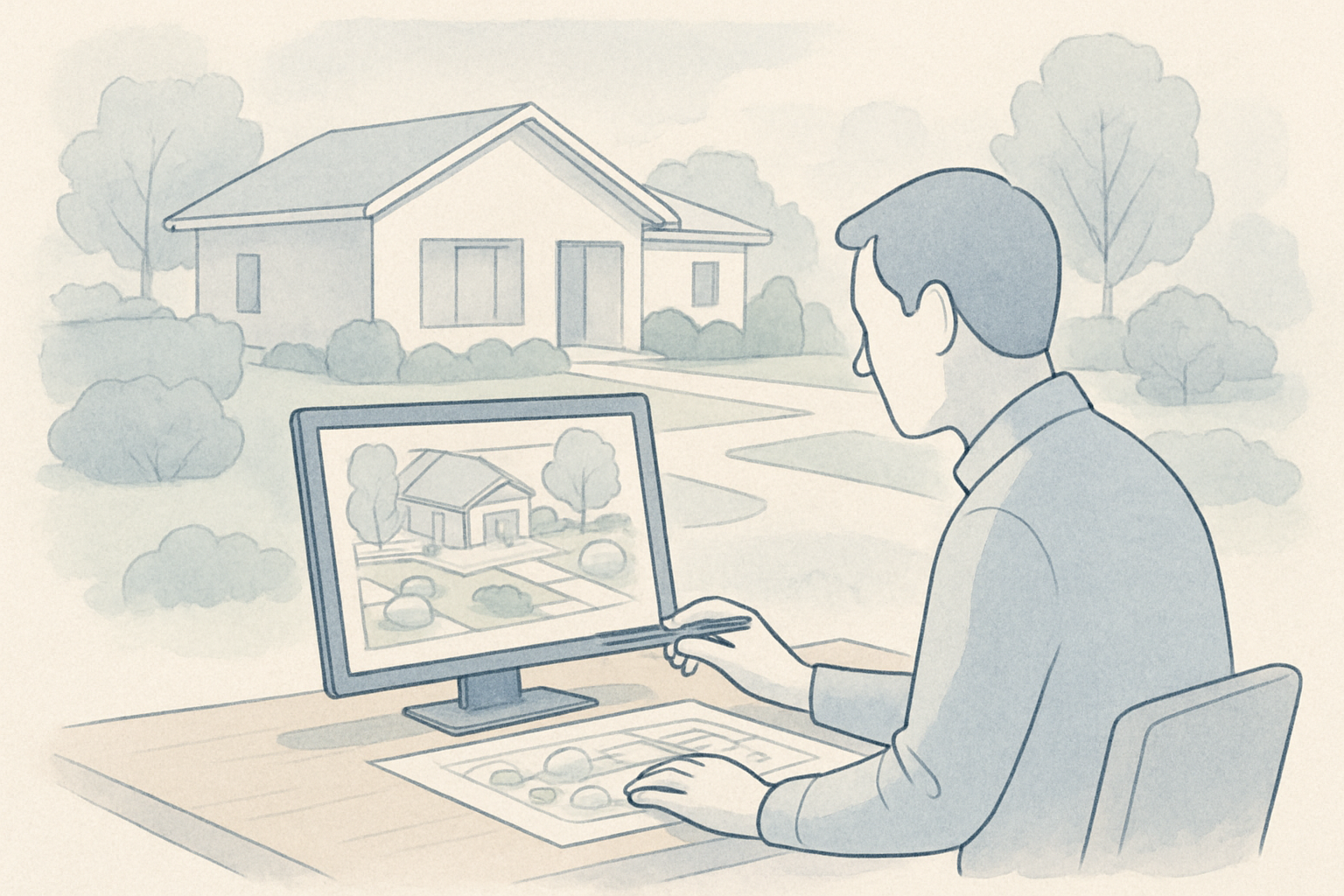The Home Loan Arranger Jason Ruedy Top 1% Jason Ruedy, CEO of The Home Loan Arranger, advises Colorado residents to merge their debts using The Home Loan Arranger amid the declining housing ...
Backyard Mud to Digital Marketplace: ServeScape Advances Landscaping with AI




Mario Cambardella’s love for the outdoors began long before he became a leader in the landscaping industry. “I was always the kid in the backyard playing in the creek, getting new shoes muddy. I can still hear my mom rattling the wooden spoon, upset about the mud tracked through the house, but I just love being outdoors,” he recalls.
That early connection to nature eventually led Cambardella to landscape architecture in college, a discovery that set the foundation for his career. Today, he is the CEO and Founder of ServeScape, a tech-enabled marketplace for plant materials and landscaping services. His childhood passion has evolved into a business aimed at solving a long-standing supply chain problem in the green industry.
From Muddy Shoes to Marketplace Innovation
After graduate school, Cambardella started a design-build landscaping firm, where he quickly encountered a frustrating reality of the industry: the fragmented plant supply chain.
“I kept getting to that situation where I had to either leave a job site to get plant material or have one of my crew go. Either way, it wasn’t going to work out well,” he explains. The breaking point came in 2014 when a client needed a particular plant only available at farms in North Carolina and Tennessee.
“I said, ‘Why can’t I get the Uber for plant material? Why can’t I have this delivery?'” Cambardella discovered that the plant supply chain was “very fragmented, very messy.” His solution: build technological tools to aggregate plant inventories directly from growers before they reach nurseries, the genesis of ServeScape.
Building a Digital Plant Ecosystem
Creating a marketplace for living goods presented unique challenges. “It starts with data,” Cambardella explains. “It starts with having a robust digital suite of all the data of all the plants that are grown within the southeast region.”
ServeScape now boasts approximately 10,000 plant profiles, making it one of the largest catalogs of digital plants. The company spent years building trust with growers and developing the necessary data infrastructure.
“We had to find the growers that produce all these plants and convince them this is a new opportunity for additional revenue. We’re not asking anything of them other than good quality books and inventory management, and if they don’t have that, we can supply them with the digital tools to get there.”
Perfect Timing: Pandemic Launch Accelerates Growth
ServeScape officially launched on March 10, 2020. Just one day before COVID-19 was declared a pandemic. Originally conceived as a B2B solution for design-build contractors, the company quickly pivoted when homeowner demand surged.
“Very quickly I had to take down that paywall, because homeowners wanting to purchase plant material needed a source for delivery,” Cambardella says. The pandemic actually accelerated adoption as people reimagined their outdoor spaces.
“People wanted outdoor environments where they could socialize and play. Many homeowners viewed their property differently when they had to socialize outdoors. They wanted to live more in outdoor spaces.”
From Plants to Full-Service Solutions
What began as a plant delivery service has evolved into a comprehensive landscaping solution. “Our maturation was, let’s start with live goods, the plants, then let’s move it to design. And then, now, last year, we added installation,” Cambardella explains.
Today, customers can select plants, add design services, and with one click, arrange for installation all through the ServeScape platform. The installation is handled by ServeScape’s “pro customers,” landscaping professionals who purchase through the platform.
“We have about 750 pro customers, and we take the top 1% of that group and say, ‘We’ve seen your portfolio. You buy substantial material from us. Would you like to participate in a program where you’re given an address, all the plants show up, and you just dig and plant them?'”
This innovative approach creates a win-win situation. Homeowners get seamless service, while landscaping professionals get jobs without having to handle design, sourcing, or payment collection. “They just have to do what they do well, and that’s construction management,” says Cambardella.
Plant Nerd AI: Harnessing Decades of Horticultural Research


ServeScape’s latest innovation is “Plant Nerd AI,” an artificial intelligence tool that helps customers select the right plants for their specific needs by leveraging decades of academic research.
“University of Georgia has a wonderful research database. 40 years worth of papers on growing hydrangeas, azaleas, and pest management,” he says. “We take 40 years of research and incorporate it into our Plant Nerd AI.”
The system combines this research with ChatGPT’s language capabilities to provide personalized plant recommendations. “If you said, ‘I want to create a pollinator garden, how do I do that?’ It pulls all the research information, reads the ServeScape catalog, and recommends the appropriate plants based on academic research, presenting them in a recipe-like format.”
Strategic Geographic Expansion
ServeScape’s expansion strategy is methodical, focusing on building a network of growers between existing and target markets. “We strategically recruit farms between Atlanta and our next launch municipality,” Cambardella explains.
The company first expanded to Greenville, South Carolina, leveraging relationships with Georgia growers. Next came Charlotte, North Carolina, after building relationships with growers between Greenville and Charlotte. The Research Triangle area (Raleigh-Durham) is next on the horizon.
When selecting new markets, ServeScape considers three key factors: proximity of growers, number of new homes being built, and median home income in the area.
Maximizing Property Value Through Strategic Landscaping


Citing recent comments from Charlie Munger, Cambardella notes that investing in landscaping can yield three times the return on investment for home value. For homeowners planning to sell, he offers this advice: “Plants: the first year they sleep, the second year they creep, and the third year they leap.”
This means the best time to landscape for maximum value is about three years before selling, allowing plants to fully establish and create a mature look. For more immediate curb appeal, Cambardella emphasizes the importance of scale.
“If you have a large house and use smaller plants, it can actually diminish the apparent value of the home. It’s important to consider human scale,” he advises. “Examine the architectural structure of the home and stay within that footprint.”
Color coordination is also crucial: “Always use complementary colors that accentuate the house color or trim, responding to the architecture.”
Emerging Landscaping Trends
Several trends are shaping today’s landscaping choices:
- Vegetation fences: “Wooden fences alone can create a boxed-in appearance, but vegetation can soften this effect.”
- Slender evergreens: “Many new plant varieties are tall, evergreen, and slender. Consider arborvitaes or cryptomeria that maintain a narrower profile, accommodating smaller property footprints.”
- Native plants: “Native plants have a reputation for appearing somewhat wild, but many subspecies now exist that are more suitable for foundation plantings.”
- Low-maintenance options: “Slow-growing material means low maintenance. Fast-growing plants require high maintenance.”
Biophilia: Bringing Nature to Commercial Spaces
Beyond residential applications, ServeScape is seeing increased interest in plants for commercial spaces, particularly as companies try to entice workers back to offices.
“A key concept here is biophilia: the desire to feel connected to nature,” Cambardella explains. “In a concrete jungle environment, you can lose touch with the natural world around you.”
Access to nature in office settings offers significant benefits: “Connecting with nature can be a grounding moment, both literally and figuratively. It can restore someone mentally, supporting overall mental health.”
Cambardella shares an example from NASDAQ headquarters, where they organized a biophilic exercise for Earth Month with 50 native pollinator plants. Employees each planted one in a small container to take home, creating connections not only with nature but also with each other and the workplace.
A Counterintuitive Planting Tip
Cambardella closes with a valuable tip: “The best time to plant a flowering shrub or tree is six months before it flowers.”
He explains, “When a plant is in full bloom, all its energy goes to flowers rather than roots. It’s crucial to plant flowering trees or shrubs approximately six months before their expected bloom time for better results in your landscape.”
Similar Articles
Explore similar articles from Our Team of Experts.


Rendering of The Lancaster, courtesy of Hatch + Ulland Owen Architect Groundbreaking with SAFE partners and funders. From left to right – Worley Barker with Texas Capital, Claire Harri...


VIRGINIA BEACH, Va., July 09, 2024 (GLOBE NEWSWIRE) — Armada Hoffler (NYSE: AHH) announces that Stifel Financial Corp. (NYSE: SF), a premier wealth management and investment banking fi...


Pictured: Matt Ellis, CEO and Co-Founder, Measurabl. Johanna Fuchs-Boenisch, CEO, Susteco. Maureen Waters, Chief Growth Officer, Measurabl. The collaboration provides ESG data and software w...


Chattanooga Neighborhood Enterprises (CNE) Partners with World Changers Chattanooga For many of these families, financial resources are limited. The focus is more on caring for the family in...



